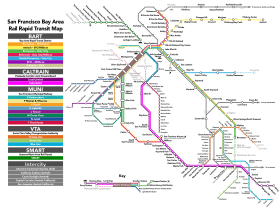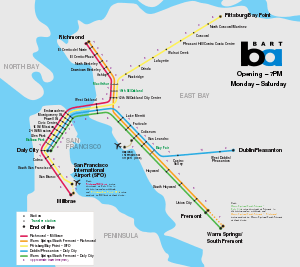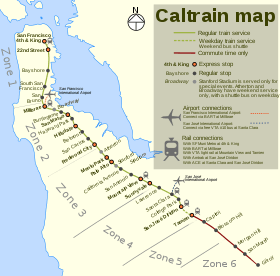Bay Area public transit
The nine counties of the San Francisco (California) Bay Area are connected by a network of local and regional transit systems. All systems listed in this guide, even those that are shuttles, are open to the general public. Excursion trains, such as the Niles Canyon Railway, are not listed here. In general the Bay Area is one of the better regions to tour the United States without a car, though there are times and places where service is awkward or rare.

Regional transit systems

AC Transit (Alameda and Contra Costa Counties)
A few routes extend beyond Alameda and Contra Costa Counties:
- Line U East Bay Express. Commuter shuttle service, with luxury coach seating, going from 🌍 Fremont BART to Stanford University in the morning and the opposite direction in the evening. $4.20; free with Stanford ID.
Altamont Corridor Express (ACE)
An Amtrak-run commuter train running from the Central Valley towns of Stockton, Tracy, Livermore and Pleasanton to San Jose. It runs only a few times a day - as of 2017, there are 4 southbound trips (to San Jose) each morning, and 4 northbound trips in the afternoon/evening, so be sure to check the schedule ahead of time.
The train shares the Santa Clara station with Caltrain. It also stops at the Great America station at Lafayette and Tasman, near the Santa Clara Convention Center, Levi's Stadium, and California's Great America.
See Santa Clara and San Jose articles for information on free shuttles which are timed to connect to ACE trains at the Great America, Santa Clara, and San Jose stations.
Amtrak Thruway Motorcoach
Amtrak has partnered with local transit agencies to offer luxury (with comfortable seats and Wi-Fi) daily bus service between San Jose and Santa Cruz and Monterey counties. As with any local bus, you can buy your ticket as you board. Clipper cards are not accepted.
- Highway 17 Express. Also listed as VTA route 970 and Santa Cruz Metropolitan Transit District route 17. Frequent daily service between downtown San Jose and Scotts Valley/Santa Cruz. $7; $3.50 senior/disabled. Request paper transfer for free or reduced-price transfers at destination.
- Monterey–San Jose Express. Also listed as VTA route 972 and Monterey-Salinas Transit (MST) route 55. Two (M–F) or 3 (Sa–Su) daily runs between downtown San Jose and Monterey, with intermediate stops in Morgan Hill, Gilroy, Prunedale, and Sand City. $12; $6 senior/disabled; MST website states that veterans are also eligible for reduced fare.
BART (Bay Area Rapid Transit)

BART is really more a commuter train for the Bay Area than a subway for San Francisco proper, as there is only one line through San Francisco, but the trains branch out in the East Bay. The system is useful within San Francisco only for trips like getting from the Mission District to Downtown, but BART is most useful for traveling to and from SFO and going between San Francisco and places in the East Bay like Oakland and Berkeley. The BART also has a shuttle to OAK. One problem with BART is that it does not run very late: With unusual exceptions, such as New Year's Eve, the last trains leave from San Francisco on their way to the East Bay at around 12:20 AM, though they are often late at that hour; the trains back from the East Bay leave Oakland later than that, as they originate some distance away (in Pittsburg/Bay Point in the northern Oakland hills; Dublin/Pleasanton southeast of Oakland; Richmond, 4 stops north of Downtown Berkeley; or Fremont, to the south in the direction of San Jose). The system is generally well maintained, with comfortable, padded seating, room for bicycles, and relatively few delays except late at night. Fares are by distance, and if you use a fare card, you must put it through a machine on your way in and out of the system. Should you end up needing to add more money to your card before leaving, there are highly visible "add fare" machines at your service.
Transferring from BART
If you plan to board an AC Transit bus at the BART station, be sure to visit the transfer machines before leaving the station. You will get a two-part paper transfer, the first part being good for an immediate $0.25 credit, and the second part for a credit on your return trip to BART, within 72 hours. If you are using a Clipper card, this is unnecessary; the card automatically deducts your transfer credit from the fare charged. VTA no longer accepts paper transfers but will give Clipper users a $0.50 fare credit for transfers from Fremont BART. Eventually, transfers from BART to all other transit agencies will be handled via the Clipper card.
CalTrain

Caltrain is a commuter train system running along the Peninsula between San Francisco, San Jose and Gilroy. Ticket prices vary by the distance between stations, but usually run around $3-6 one way. Trains run about once every half hour, on average, once an hour late evenings and weekends, with several more trains running during commute hours. This train service is not particularly fast; however, in a move to improve speed, many trains during commute hours run express or semi-express service, so they do not stop at all stations. Tickets must be purchased before boarding the train from ticket vending machines at any of the stations or from ticket clerks at staffed stations. Tickets are checked on the trains and anyone found without a ticket is liable to a substantial fine. Cyclists should use the designated car at the northern end of the train, and be aware that bike space is often limited during commute hours.
If transferring between Caltrain and BART, the cheapest option is to transfer in Millbrae (the southernmost BART station on the Peninsula). Get off in Millbrae and follow the signs to make your connection.
Golden Gate Transit and Ferry
Modesto Area Express (MAX)
MAX runs service primarily geared for commuters who live in Modesto and work in the Bay Area. Limited reverse-commute service is available on some lines; call for details. Reservations are recommended, as preference is given to monthly-pass holders. Individual fares are cash only; exact change is required.
- Modesto BART Express, ☎ +1 209 521-1274. M–F, except holidays. Two AM and two PM buses between Modesto and the Dublin/Pleasanton BART station. No bike racks (unlike other MAX buses). $14 one-way; $16 same-day round trip.
- Modesto ACE Express, ☎ +1 209 521-1274. M–F, except holidays. Service between Modesto and the Manteca/Lathrop ACE station. $3 one-way.
San Francisco Bay Ferry
Local transit systems
Bear Transit (UC Berkeley)
An outgrowth of the Humphrey Go-Bart shuttle launched in the 1970s, Bear Transit offers daytime weekday (M-F) service around the UC Berkeley campus and beyond, including BART stations, the 🌍 UC Botanical Gardens, 🌍 Lawrence Hall of Science, downtown Berkeley, and points in El Cerrito and Richmond. General public: $1–$1.50. Info at 511.org web site but not on their phone line.
County Connection (Contra Costa County)
Emery Go-Round (Emeryville)
FAST (Fairfield and Suisun Transit)
Marguerite Shuttle (Stanford)
Easily the best transit bargain in the Bay Area—free to everyone—Marguerite buses traverse the Stanford University campus, with most routes stopping at the 🌍 Medical Center, 🌍 Shopping Center, and 🌍 Palo Alto Transit Center (for connections to VTA, SamTrans, and CalTrain). Some lines extend farther beyond the campus, to: 🌍 Fremont BART (lines AE-F, EB); 🌍 Union City BART Station (line EB); 🌍 Menlo Park Caltrain station and 🌍 Bohannon Drive (line BOH); 🌍 Linear Accelerator (lines S, SLAC); 🌍 VA Palo Alto Health Care facility (lines R, RP, VA); 🌍 Palo Alto Tech Center, 0.3 miles from 🌍 Palo Alto Airport (line TECH); 🌍 Research Park (lines 1050A, RP). Check schedules carefully, as many lines run only during the day, M-F and/or the school year. For schedules and maps, click 511.org; unfortunately, Marguerite information is not on the 511 phone system.
Marin Transit
Marin Transit provides bus service in Marin County. In addition to connecting the Marin County cities, it offers a seasonal shuttle to Muir Woods (buses 66 and 66F), and the West Marin stagecoach goes to Stinson Beach (bus 61) and Point Reyes (bus 68). The system's biggest hub is the San Rafael Transit Center in San Rafael, with smaller hubs in Novato, San Anselmo, and Marin City. Connections to Golden Gate Transit buses to San Francisco, Richmond, and Sonoma County are available.
Marin Transit's service is sometimes late and not always convenient, but if you're visiting Marin without a car, it gets the job done.
Muni (San Francisco)
SamTrans (San Mateo County)
Santa Clara Valley Transportation Authority (VTA)
VTA provides transit throughout Santa Clara County:
- Light rail. lines 900, 901, 902 connect Mountain View, Sunnyvale, Santa Clara, Milpitas, San Jose, and Campbell, faster than regular buses, but still a bit slow through downtown San Jose. Buy your ticket on the platform before boarding train. You can freely transfer between light-rail lines but must complete your trip within 2 hours. Bikes are allowed on board and are hung vertically from hooks at the end of cars. If your bike is heavy or loaded with panniers, this can be difficult. Adults single $2.25/8-hour pass $4.50/day pass $7; Youth (5-18) $1/$2/$3; Sr (65+)–Disabled–Medicare $1/$2/$3.
- Regular, Limited Stop, and Rapid buses. travel along surface streets. On a few routes, Limited Stop buses provide faster service than the corresponding regular buses. Rapid buses are like Limited Stop, except that they do not wait at way points, so that if traffic is lighter than expected, a bus might leave a stop before the time indicated on the schedule. There is one Rapid line, 522, along the same route as line 22. Adults single $2.25/day pass $7; youth (5-18) $1/$3; senior (65+)–disabled–medicare $1/$3.
- Express buses. use freeways and expressways to travel longer routes. Adults single $4.50/day pass $13.50; youth (5-18) $1/$3; senior(65+)–disabled–medicare $1/$3.
- Community buses. cover smaller neighborhood and shopping areas. Same as Regular, Limited Stop, and Rapid buses.
- Shuttles. provide connections with other transportation systems. For example, line 10 connects the SJC airport to Caltrain and light rail, line 201/DASH goes from the San Jose train station to a light rail stop and points in downtown San Jose, and several routes take ACE riders to Silicon Valley companies. Free.
Transfers are available within 2 hours. Day-pass pricing is via the Clipper card; you will stop being charged when you reach the daily rate.
SMART (Sonoma-Marin Area Regional Transit)
Sonoma-Marin Area Rail Transit (SMART) is a light rail line opened in 2017 that connects Marin County and Sonoma County, with stops at Sonoma County Airport, Santa Rosa, Rohnert Park, Petaluma, Novato, and San Rafael. Extensions are planned to Cloverdale and Larkspur. Fares depend on a zone system and must be paid by Clipper card or an "eTickets" app.
SolTrans (Solano County)
Sonoma County Transit
Tri Delta Transit (eastern Contra Costa County)
Vacaville City Coach
VINE (Napa County)
WestCAT (western Contra Costa County)
Wheels (Alameda County: Dublin, Pleasanton, Livermore)
Basic fare is $2. Transfers between Wheels buses or to ACE are generally free. A transfer from BART costs $1.
Clipper card

The Clipper card is a smart card for pre-paying transit fares. Benefits of using the card can include the convenience of not having to put money into fare boxes for individual rides, and cost savings when making multiple trips.
As of January 2016, the use of Clipper to pay for parking is being tested in 5 San Francisco garages.
Should I buy a Clipper card?
You do not need a card to use public transit in the Bay Area, since you can always deposit money into a fare box or ticket machine. The card costs $3, plus the money you pre-pay for rides, so it probably doesn't make sense if you plan to take only a few rides on public transit. On the other hand, some agencies (e.g., BART, CalTrain) charge less for tickets purchased with Clipper. Savings can be even greater when you take several rides on the same day. For instance, the Santa Clara Valley Transportation Agency (VTA) no longer issues transfers or day passes, but the maximum daily amount that is charged to the card of an adult (age 19–64) for non-Express rides on the system is $6, the cost of 3 individual adult rides. (For seniors, the maximum is equivalent to 2.5 senior rides.) Also, fare credits for some inter-system transfers (e.g., between BART and a local bus) are given only to those using the Clipper card. An additional factor to weigh is the convenience of not having to deposit exact change into fare boxes, versus the inconvenience of buying and recharging the card.
Buying and reloading the card
Clipper cards for adults can be purchased for $3 at most Bay Area Walgreens and Whole Food stores and other retail locations. Youths (age 5 to 17 or 18, depending on the transit agency), seniors (65 or older), and the disabled are eligible for special cards that are good for discounted rides. You can get these from a Regional Transit Connection center (typically, the offices of the local transit agency) or by mail (allow 10 days for delivery). For details, go to www.clippercard.com/ClipperWeb/discounts/index.do or call one of the customer service numbers listed in section For more information, below. Allow 10 days for delivery.
Once you have the card, you can add cash value to it at any of the retail locations, online, or at BART (cash only), VTA light-rail, or SF Muni ticket machines. Some Cal-Train stations also have Clipper Add-Value machines.The first time you add value online, there will be a delay of a few days before it appears on your card.
Using the card
Clipper card readers are located on buses and at train stops. Hold the card next to the reader. It is not usually necessary to remove the card from your wallet. The reader display will indicate whether the payment was successful, and how much money is left on the card.
For some systems, like BART and Caltrain, the fare varies by distance traveled. So you need to tap the card twice - upon beginning and ending your ride - so that you are charged the correct fare. (If you forget to "tap out" at the end of your Caltrain ride, you may be charged a higher fare.)
Transfers
Sometimes when you transfer from one public-transit vehicle to another (e.g., from BART to a bus) the fare for the second ride is discounted. Procedures vary by transit agency. In some cases, the discount is applied automatically (if you used the card for both rides). In others, you can save money by requesting a paper transfer. Ask the vehicle operator or station agent which procedure applies.
For more information
Questions specifically about Clipper cards are addressed at the Clipper web site (www.clippercard.com), via e-mail (custserv@clippercard.com), or on their customer-service phone lines (voice: +1-877-878-8883; fax: +1 925 686-8221; TDD/TTY: +1-800-735-2929). For more information about all of the Bay Area transit systems, go to 511.org, or call 511 from a phone from within the Bay Area.
Using 511 to get transit information
Each transit agency has its own web site and telephone lines, but schedules and interactive trip-planning information for all the systems are also available at 511.org, or, except as noted below, by calling 511 from a phone within the Bay Area. 511.org covers not only public transit, but also other transportation modes, such as driving, bicycling, and ridesharing.
You can use the information on bus-stop signs to find out when the next bus will arrive. Call 511 and say "departure times". The system prompts you for the stop ID. Keying in the ID usually works better than saying it, as the voice recognition is unreliable. The system responds with a not very exact estimate of how many minutes you need to wait.